Spatially Consistent High-Resolution Land Surface Temperature Mosaics for Thermophysical Mapping of the Mojave Desert
Abstract
1. Introduction
1.1. Surface Geomorphic and Ecological Mapping
1.2. Thermophysical Mapping
1.3. High-Resolution TIR Mosaics
2. Methods
2.1. Remote Sensing Data
2.2. Data Acquisition and Processing Steps
2.3. Scene Selection
2.4. Line- and Row-Correlated Noise Removal
2.5. Mosaic Steps
2.6. Field Validation
3. Results
4. Interpretations and Discussion
4.1. Errors in the Application of ATI
4.2. Validation and Interpretation of the ATI Dataset
5. Conclusions
Author Contributions
Funding
Acknowledgments
Conflicts of Interest
References
- Hutchinson, G.E. Concluding remarks. Cold Spring Harb. Symp. Quant. Biol. 1957, 22, 415–427. [Google Scholar] [CrossRef]
- Begon, M.; Harper, J.L.; Townsend, C.R. Ecology from Individuals to Ecosystems; Wiley-Blackwell: Malden, MA, USA, 1998. [Google Scholar]
- Soberón, J. Grinnellian and Eltonian niches and geographic distributions of species. Ecol. Lett. 2007, 10, 1115–1123. [Google Scholar] [CrossRef] [PubMed]
- Elith, J.; Leathwick, J.R. Species Distribution Models: Ecological Explanation and Prediction across Space and Time. Annu. Rev. Ecol. Evol. Syst. 2009, 40, 677–697. [Google Scholar] [CrossRef]
- Tracy, C.R. A model of the dynamic exchanges of water and energy between a terrestrial amphibian and its environment. Ecol. Monogr. 1976, 46, 293–326. [Google Scholar] [CrossRef]
- Lovich, J.E.; Bainbridge, D. Anthropogenic degradation of the Southern California desert ecosystem and prospects for natural recovery and restoration. Environ. Manag. 1999, 24, 309–326. [Google Scholar] [CrossRef]
- Webb, R.H.; Fenstermaker, L.; Heaton, J. The Mojave Desert: Ecosystem Processes and Sustainability; University of Nevada Press: Reno, NV, USA, 2009. [Google Scholar]
- Parmesan, C.; Root, T.L.; Willig, M.R. Impacts of extreme weather and climate on terrestrial biota. Bull. Am. Meteorol. Soc. 2000, 81, 443–450. [Google Scholar] [CrossRef]
- Araújo, M.B.; Cabeza, M.; Thuiller, W.; Hannah, L.; Williams, P.H. Would climate change drive species out of reserves? Glob. Chang. Biol. 2004, 10, 1618–1626. [Google Scholar] [CrossRef]
- Parmesan, C. Ecological and evolutionary responses to recent climate change. Annu. Rev. Ecol. Evol. Syst. 2006, 37, 637–669. [Google Scholar] [CrossRef]
- Inman, R.D.; Esque, T.C.; Nussear, K.E.; Leitner, P.; Matocq, M.D.; Weisberg, P.J.; Dilts, T.E.; Vandergast, A.G. Is there room for all of us? Renewable energy and Xerospermophilus mohavensis. Endanger. Species Res. 2013, 20, 1–18. [Google Scholar] [CrossRef]
- Vandergast, A.G.; Inman, R.D.; Barr, K.R.; Nussear, K.; Esque, T.; Hathaway, S.A.; Wood, D.A.; Medica, P.A.; Breinholt, J.W.; Stephen, C.L.; et al. Evolutionary hotspots in the Mojave Desert. Diversity 2013, 5, 293–319. [Google Scholar] [CrossRef]
- Ferrier, S.; Watson, G. An Evaluation of the Effectiveness of Environmental Surrogates and Modelling Techniques in Predicting the Distribution of Biological Diversity; Department of the Environment and Energy, Australian Government: Canberra, Australia, 1997.
- Isaak, D.J.; Wenger, J.; Young, M.K. Big biology meets microclimatology: Defining thermal niches of ectotherms at landscape scales for conservation planning. Ecol. Appl. 2017, 27, 977–990. [Google Scholar] [CrossRef] [PubMed]
- Ludington, S.; Moring, B.C.; Miller, R.J.; Stone, P.A.; Bookstrom, A.A.; Bedford, D.R.; Evans, J.G.; Haxel, G.A.; Nutt, C.J.; Flyn, K.S.; et al. Preliminary Integrated Geologic Map Databases for the United States; Geological Survey Open-File Report; USGS: Reston, VA, USA, 2007; 47p.
- Schweitzer, P.N. Combined Geologic Map Data for the Conterminous US Derived from the USGS State Geologic Map Compilation. 2011. Available online: http://mrdata.usgs.gov/geology/state/geol_poly.zip (accessed on 1 December 2011).
- Natural Resources Conservation Service (NRCS), United States Department of Agriculture. U.S. General Soil Map (STATSGO2). Available online: http://soildatamart.nrcs.usda.gov (accessed on 1 May 2013).
- Wiken, E.; Jiménez Nava, F.; Griffith, G. North American Terrestrial Ecoregions—Level III; Commission for Environmental Cooperation: Montreal, QC, Canada, 2011; 149p. [Google Scholar]
- Kahle, A.B.; Gillespie, A.R.; Goetz, A.F. Thermal inertia imaging: A new geologic mapping tool. Geophys. Res. Lett. 1976, 3, 26–28. [Google Scholar] [CrossRef]
- Price, J.C. Thermal inertia mapping: A new view of the earth. J. Geophys. Res. 1977, 82, 2582–2590. [Google Scholar] [CrossRef]
- Pratt, D.; Ellyett, C. The thermal inertia approach to mapping of soil moisture and geology. Remote Sens. Environ. 1979, 8, 151–168. [Google Scholar] [CrossRef]
- Price, J.C. On the analysis of thermal infrared imagery: The limited utility of apparent thermal inertia. Remote Sens. Environ. 1985, 18, 59–73. [Google Scholar] [CrossRef]
- Kahle, A.B. Surface emittance, temperature, and thermal inertia derived from Thermal Infrared Multispectral Scanner (TIMS) data for Death Valley, California. Geophysics 1987, 52, 858–874. [Google Scholar] [CrossRef]
- Scheidt, S.; Ramsey, M.; Lancaster, N. Determining soil moisture and sediment availability at White Sands Dune Field, New Mexico, from apparent thermal inertia data. J. Geophys. Res. 2010, 115, F02019. [Google Scholar] [CrossRef]
- Carslaw, H.S.; Jaeger, J.C. Conduction of Heat in Solids, 2nd ed.; Oxford University Press: Oxford, UK, 1959. [Google Scholar]
- Kieffer, H.H.; Chase, S.C., Jr.; Miner, E.; Münch, G.; Neugebauer, G. Preliminary report on infrared radiometric measurements from the Mariner 9 spacecraft. J. Geophys. Res. 1973, 78, 4291–4312. [Google Scholar] [CrossRef]
- Gillespie, A.R.; Kahle, A.B. Construction and interpretation of a digital thermal inertia image. Photoqrammetric Eng. Remote Sens. 1977, 43, 983–1000. [Google Scholar]
- Watson, K. Topographic Slope Correction for Analysis of Thermal Infrared Images; NASA: Washington, DC, USA, 1982.
- Nowicki, S.A. Thermophysical Characterization of the Southwestern US from Five Years of 8-Day MODIS Land Surface Temperature Observations. IEEE J. Sel. Top. Appl. Earth Obs. Remote Sens. 2014, 7, 3416–3420. [Google Scholar] [CrossRef]
- Price, J.C. The potential of remotely sensed thermal infrared data to infer surface soil moisture and evaporation. Water Resour. Res. 1980, 16, 787–795. [Google Scholar] [CrossRef]
- Hulley, G.C.; Hook, S.J.; Baldridge, A.M. ASTER Land Surface Emissivity Database of California and Nevada. Geophys. Res. Lett. 2008, 35, L13401. [Google Scholar] [CrossRef]
- Scheidt, S.; Ramsey, M.S.; Lancaster, N. Radiometric normalization and image generation of ASTER thermal infrared data: An application to extensive sand sheets and dune fields. Remote Sens. Environ. 2008, 112, 920–933. [Google Scholar] [CrossRef]
- Hazaymeh, K.; Hassan, Q.K. Fusion of MODIS and Landsat-8 Surface Temperature Images: A New Approach. PLoS ONE 2015, 10, e0117755. [Google Scholar] [CrossRef] [PubMed]
- Christensen, P.R.; Jakosky, B.M.; Kieffer, H.H.; Malin, M.C.; McSween, H.Y.; Nealson, K.; Mehall, G.L.; Silverman, S.H.; Ferry, S.; Caplinger, M.; et al. The Thermal Emission Imaging System (THEMIS) for the Mars 2001 Odyssey Mission. Space Sci. Rev. 2004, 110, 85–130. [Google Scholar] [CrossRef]
- Edwards, C.S.; Nowicki, K.J.; Christensen, P.R.; Hill, J.; Gorelick, N.; Murray, K. Mosaicking of global planetary image datasets: 1. Techniques and data processing for Thermal Emission Imaging System (THEMIS) multi-spectral data. J. Geophys. Res. 2011, 116, E10008. [Google Scholar] [CrossRef]
- Abrams, M. The Advanced Spaceborne Thermal Emission and Reflection Radiometer (ASTER): Data products for the high spatial resolution imager on NASA’s Terra platform. Int. J. Remote Sens. 2000, 21, 847–859. [Google Scholar] [CrossRef]
- Gillespie, A.; Rokugawa, S.; Matsunaga, T.; Cothern, J.S.; Hook, S.; Kahle, A.B. A temperature and emissivity separation algorithm for Advanced Spaceborne Thermal Emission and Reflection Radiometer (ASTER) images. IEEE Trans. Geosci. Remote Sens. 1998, 36, 1113–1126. [Google Scholar] [CrossRef]
- Salomonson, V.V.; Barnes, W.L.; Maymon, P.W.; Montgomery, H.E.; Ostrow, H. MODIS: Advanced facility instrument for studies of the Earth as a system. IEEE Trans. Geosci. Remote Sens. 1989, 27, 145–153. [Google Scholar] [CrossRef]
- Masek, J.G.; Vermote, E.F.; Saleous, N.E.; Wolfe, R.; Hall, F.G.; Huemmrich, K.F.; Gao, F.; Kutler, J.; Lim, T.K. A Landsat surface reflectance data set for North America, 1990–2000. IEEE Geosci. Remote Sens. Lett. 2006, 3, 68–72. [Google Scholar] [CrossRef]
- Liang, S. Narrowband to broadband conversions of land surface albedo 1 Algorithms. Remote Sens. Environ. 2001, 76, 213–238. [Google Scholar] [CrossRef]
- Bandfield, J.L.; Rogers, D.; Smith, M.D.; Christensen, P.R. Atmospheric correction and surface spectral unit mapping using Thermal Emission Imaging System data. J. Geophys. Res. 2004, 109, E10008. [Google Scholar] [CrossRef]
- Nowicki, K.J.; Edwards, C.S.; Christensen, P.R. Post-projection removal of row- and column-correlated noise in line-scanning data: application to THEMIS infrared data. In Proceedings of the 5th Workshop on Hyperspectral Image and Signal Processing: Evolution in Remote Sensing (Whispers), Gainesville, FL, USA, 26–28 June 2013. [Google Scholar]
- Du, Y.; Cihlar, J.; Beaubien, J.; Latifovic, R. Radiometric normalization, compositing, and quality control for satellite high resolution image mosaics over large areas. IEEE Trans. Geosci. Remote Sens. 2001, 39, 623–634. [Google Scholar]
- Hulley, G.C.; Hook, S.J. Generating consistent land surface temperature and emissivity products between ASTER and MODIS data for Earth science research. IEEE Trans. Geosci. Remote Sens. 2011, 49, 1304–1315. [Google Scholar] [CrossRef]
- Skuse, R.J. Soil Moisture Recognition and The Spatial Distribution of Storm Activity in the Mojave Desert Using High—Resolution Aster and Modis Imagery for Thermophysical Mapping. Master’s Thesis, University of Nevada Las Vegas, Las Vegas, NV, USA, 2013. [Google Scholar]
- Masamune, S.; Smith, J.M. Thermal conductivity of beds of spherical particles. Ind. Eng. Chem. Fundam. 1963, 2, 136–143. [Google Scholar] [CrossRef]
- Wechsler, A.E.; Glaser, P.E. Pressure effects on postulated lunar materials. Icarus 1965, 4, 335–352. [Google Scholar] [CrossRef]
- Hewson, R.D.; Cudahy, T.J.; Mizuhiko, S.; Ueda, K.; Mauger, A.J. Seamless geological map generation using ASTER in the Broken Hill-Curnamona province of Australia. Remote Sens. Environ. 2005, 99, 159–172. [Google Scholar] [CrossRef]
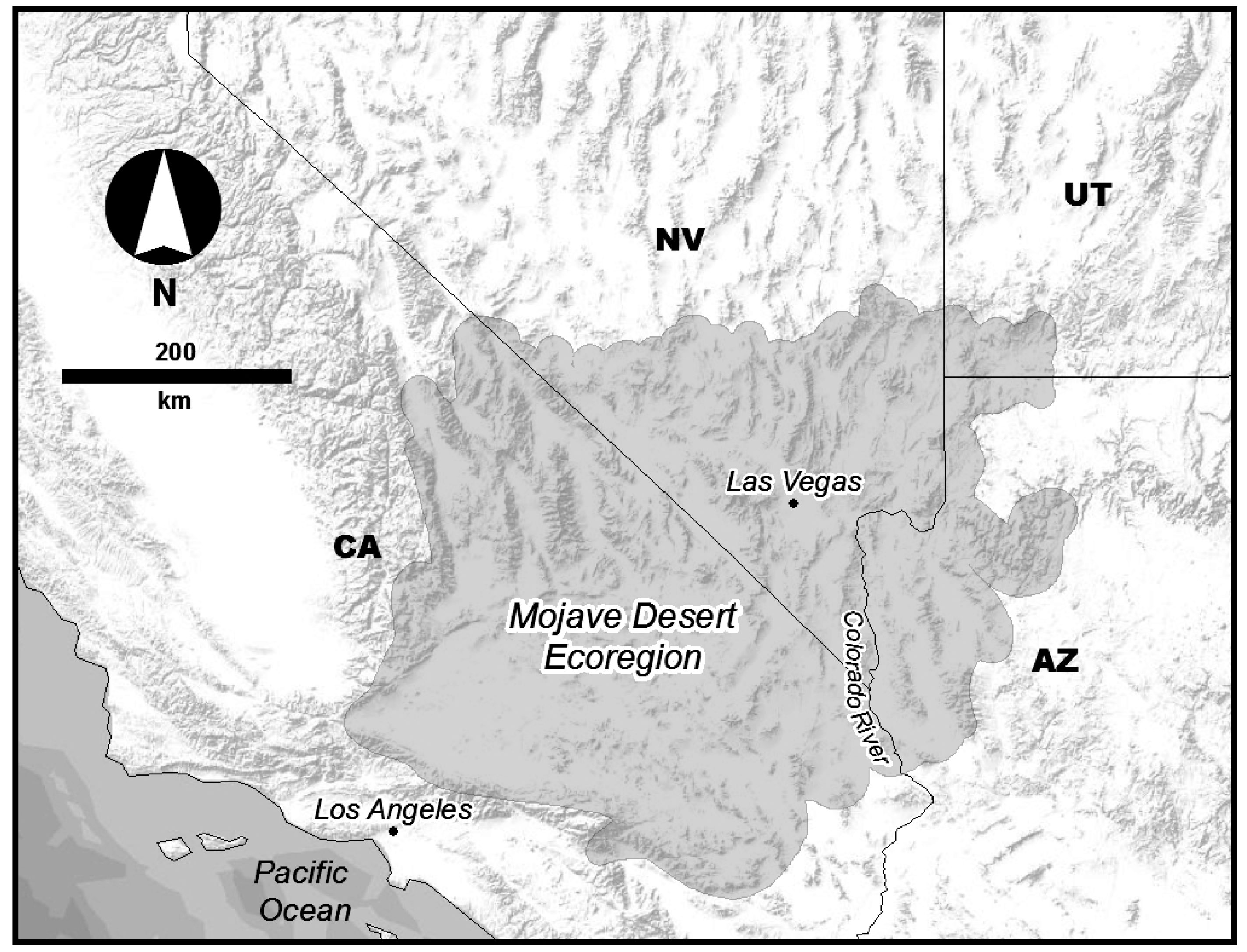

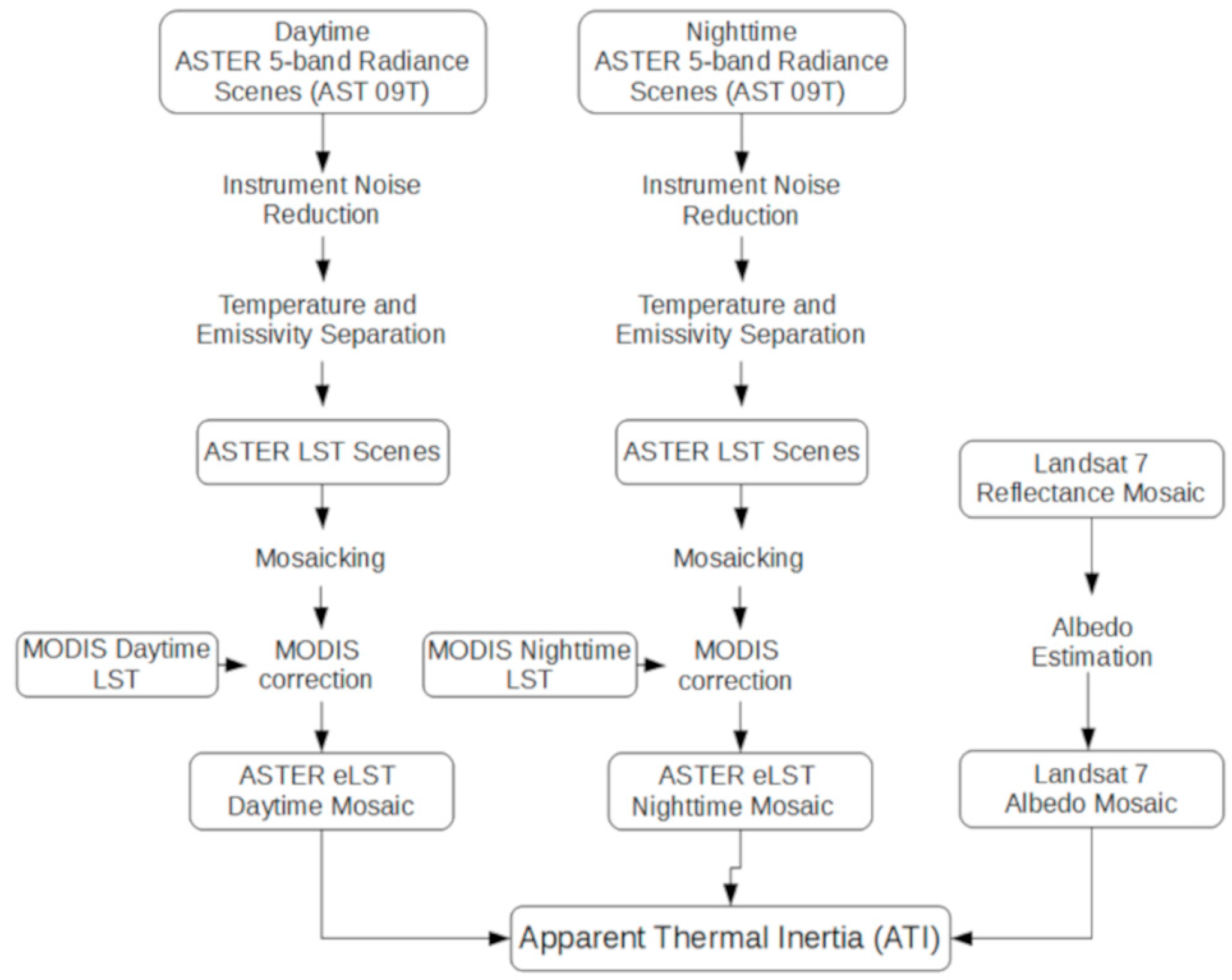

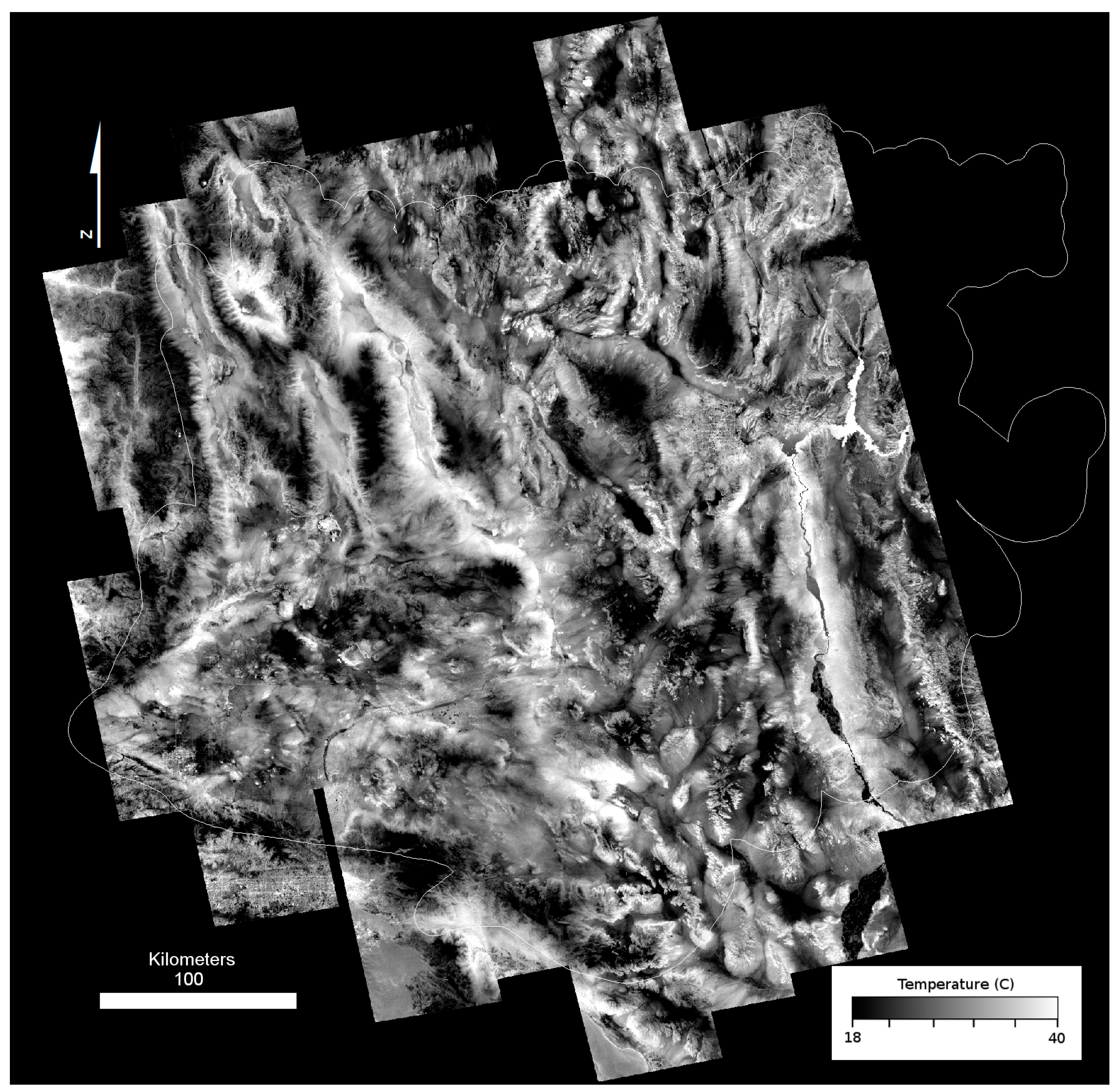
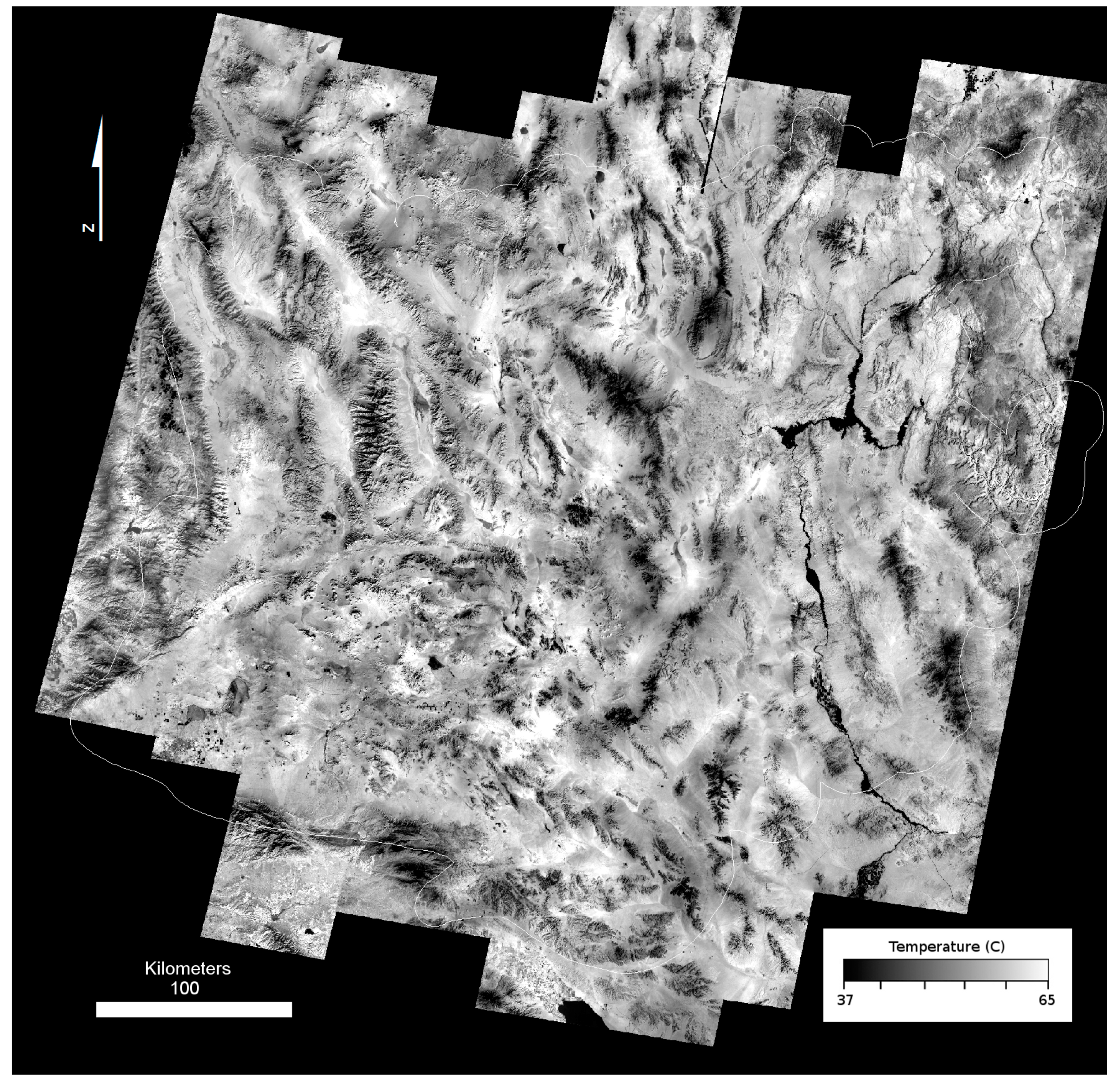
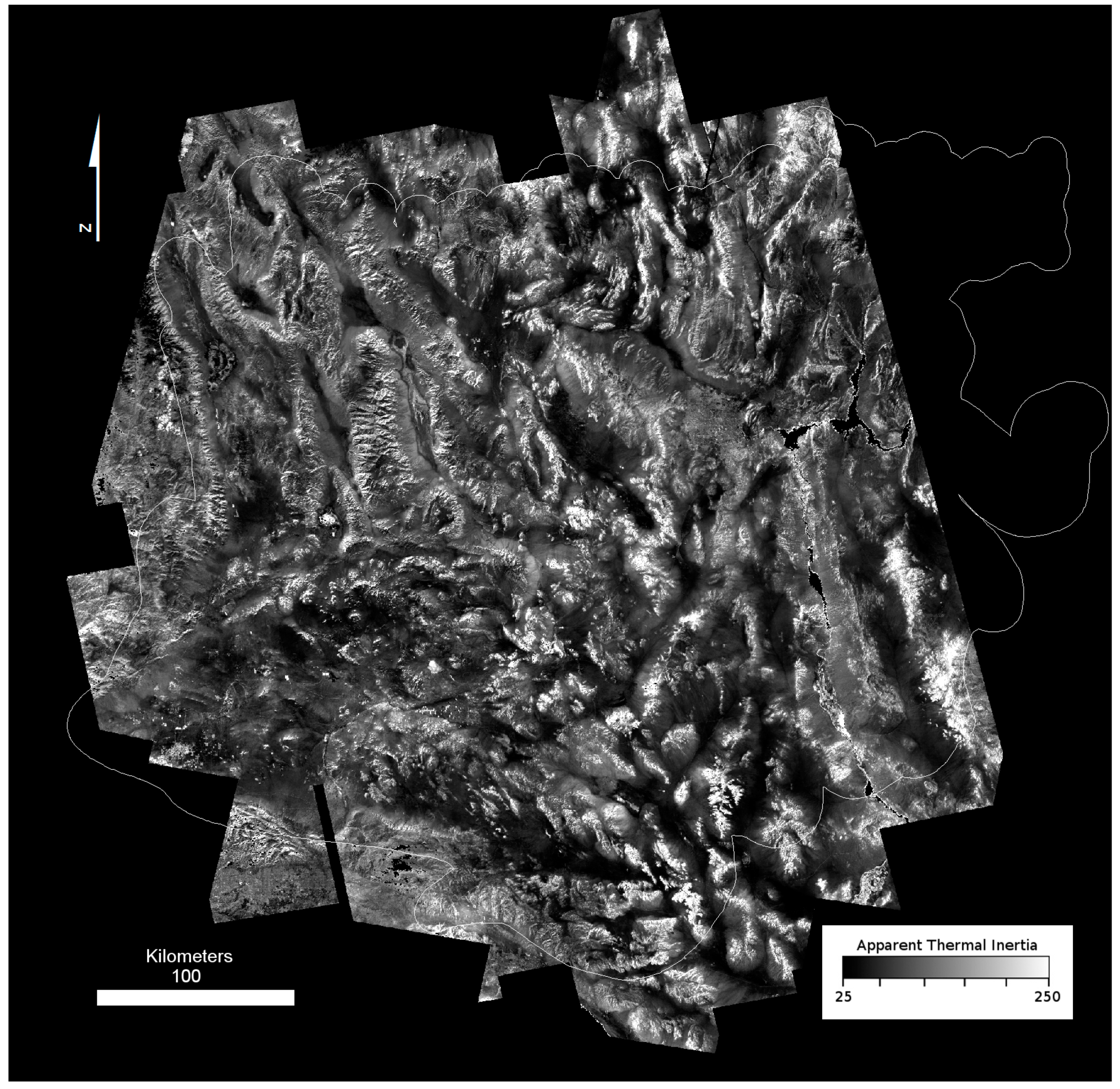
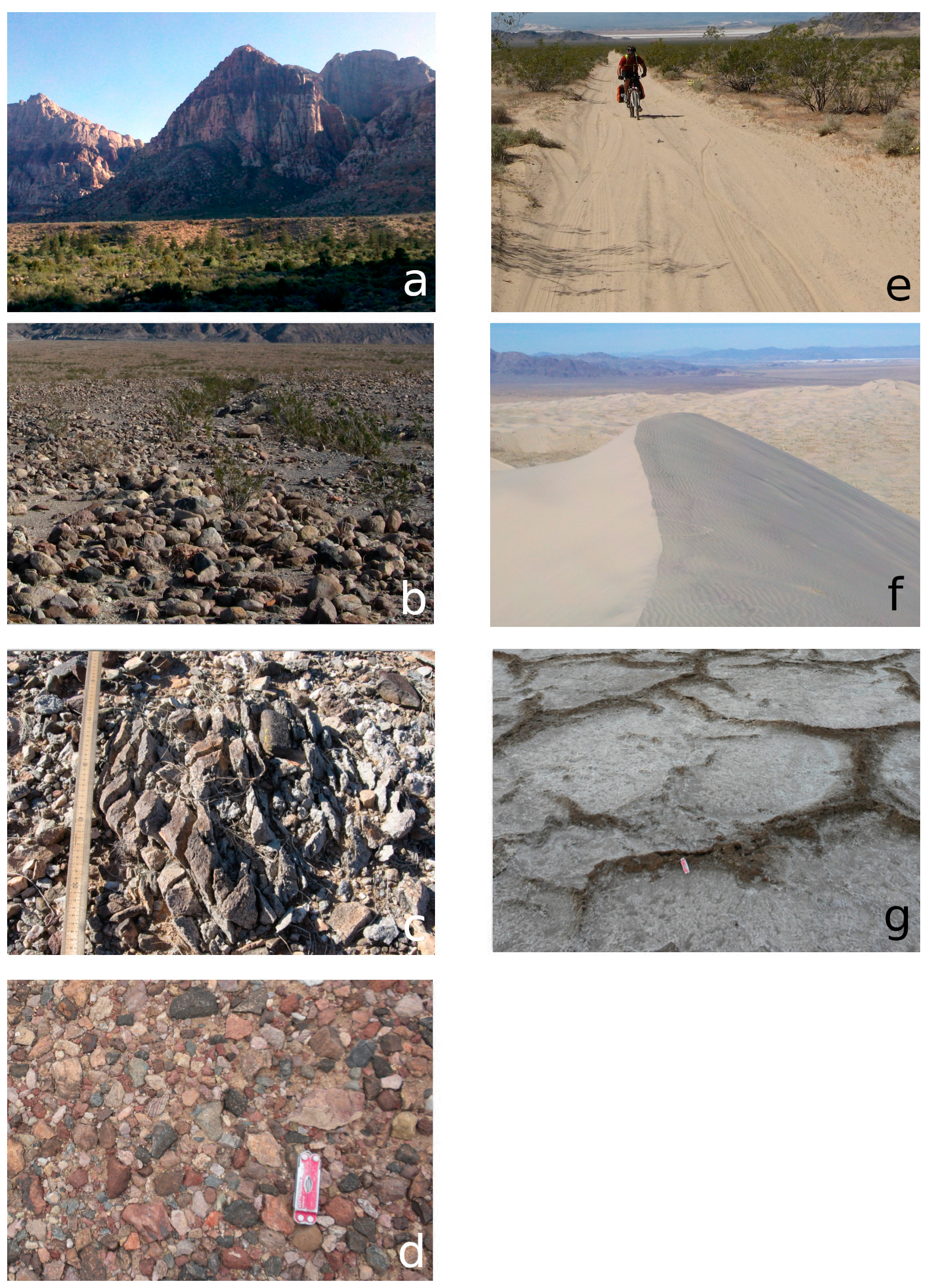

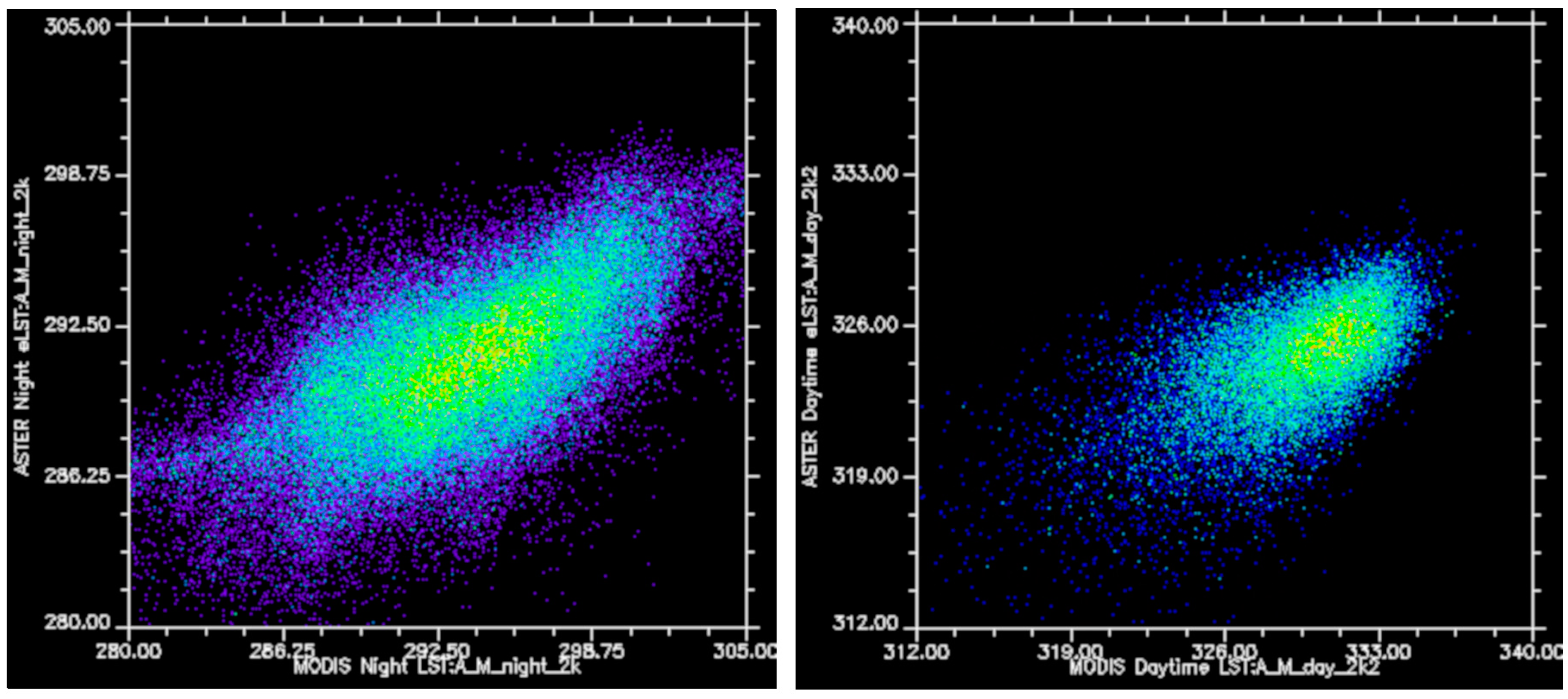
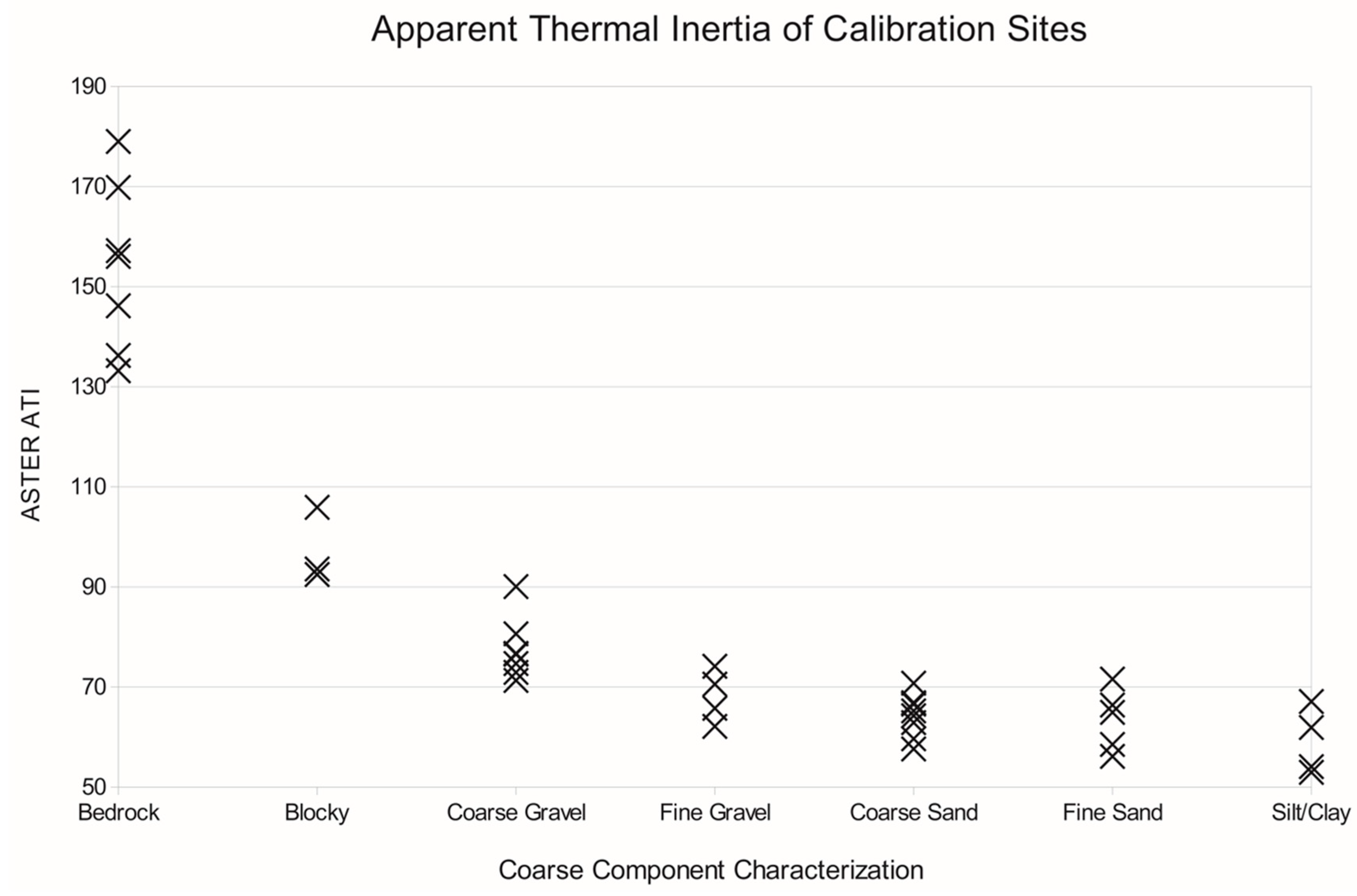
| Nighttime ASTER Mosaic Scene | Daytime ASTER Mosaic Scene | ||||
|---|---|---|---|---|---|
| Acquisition Dates | Number of Scenes | Acquisition Dates | Number of Scenes | ||
| 11/17/2011 | 4 | 10/13/2010 | 7 | ||
| 10/17/2011 | 8 | 10/11/2010 | 6 | ||
| 9/29/2011 | 7 | 8/12/2010 | 7 | ||
| 8/30/2011 | 8 | 6/7/2010 | 8 | Core Strip | |
| 7/20/2011 | 3 | 9/23/2008 | 8 | ||
| 7/2/2011 | 4 | 7/19/2008 | 8 | ||
| 7/1/2010 | 8 | Core Strip | 11/13/2007 | 8 | |
| 4/10/2010 | 6 | 8/15/2006 | 4 | ||
| 11/17/2009 | 4 | 7/13/2005 | 7 | ||
| 3/12/2008 | 3 | 9/19/2004 | 7 | ||
| 3/5/2008 | 7 | 6/15/2004 | 4 | ||
| 12/2/2006 | 2 | ||||
| 11/20/2006 | 6 | ||||
| 8/21/2006 | 5 | ||||
| 8/14/2006 | 2 | ||||
| 7/19/2005 | 8 | ||||
| 85 | Total | 74 | Total | ||
© 2019 by the authors. Licensee MDPI, Basel, Switzerland. This article is an open access article distributed under the terms and conditions of the Creative Commons Attribution (CC BY) license (http://creativecommons.org/licenses/by/4.0/).
Share and Cite
Nowicki, S.A.; Inman, R.D.; Esque, T.C.; Nussear, K.E.; Edwards, C.S. Spatially Consistent High-Resolution Land Surface Temperature Mosaics for Thermophysical Mapping of the Mojave Desert. Sensors 2019, 19, 2669. https://doi.org/10.3390/s19122669
Nowicki SA, Inman RD, Esque TC, Nussear KE, Edwards CS. Spatially Consistent High-Resolution Land Surface Temperature Mosaics for Thermophysical Mapping of the Mojave Desert. Sensors. 2019; 19(12):2669. https://doi.org/10.3390/s19122669
Chicago/Turabian StyleNowicki, Scott A., Richard D. Inman, Todd C. Esque, Kenneth E. Nussear, and Christopher S. Edwards. 2019. "Spatially Consistent High-Resolution Land Surface Temperature Mosaics for Thermophysical Mapping of the Mojave Desert" Sensors 19, no. 12: 2669. https://doi.org/10.3390/s19122669
APA StyleNowicki, S. A., Inman, R. D., Esque, T. C., Nussear, K. E., & Edwards, C. S. (2019). Spatially Consistent High-Resolution Land Surface Temperature Mosaics for Thermophysical Mapping of the Mojave Desert. Sensors, 19(12), 2669. https://doi.org/10.3390/s19122669





